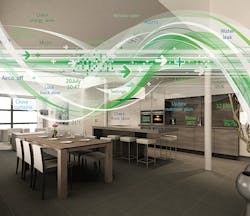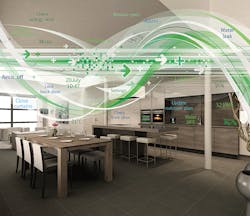What’s the Difference between ZigBee RF4CE and ZigBee Green Power?
This file type includes high-resolution graphics and schematics when applicable.
ZigBee, which is named after the dance honeybees do to communicate to other honeybees, was developed and standardized as IEEE 802.15.4 in 2004. Originally designed as an ultra-low-power wireless standard to support energy harvesting, it is now widely accepted as a low-cost, low-power wireless mesh-network standard. It is also one of the wireless standards being eyed for use in the IoT network of sensors, actuators, and Internet servers. (The other two major standards being evaluated and used are WiFi and Bluetooth.)
ZigBee has several advantages over competing standards. They include the years of experience programmers, designers, and companies have working with ZigBee, as evidenced by the more than 1,000 certified ZigBee products on the market. It also supports a large application library that has gone through several updates and rounds of improvements. IoT and smart-home firms also prefer ZigBee because it is easy to use and has strong security protocols.
ZigBee is also fully Wi-Fi- and IP-compatible, so there is no need to have a ZigBee chip in a smartphone to find and control ZigBee-connected smart-home and IoT devices. It all happens through any Web-connected hub (ZigBee-enabled router, set-top box, or gateway), which means connected PCs and smartphones (via WiFi or cellular) can function as dashboards, as they can find and communicate with any ZigBee devices without a problem.
The attraction of ZigBee centers on cost and scale. It is the first scheme, say its followers, which is inexpensive enough to be practical for use in isolated controls with sensors that must work reliably while consuming little power. ZigBee manages both feats by sending data at a super-low rate and by using a special networking scheme called meshing. The low rate, about 250 kb/s, is too low for beaming audio, real-time video, or complicated Web pages. It is fine, however, for sending small packets of data and keeping tabs on temperature sensors, proximity switches, and similar uses characterized by relatively low data-rate changes.
There are several subsets of ZigBee 3.0, including ZigBee RF4CE and ZigBee Green Power. Let’s take a closer look at both of them.
ZigBee RF4CE (Radio Frequency for Consumer Electronics) was initially an offshoot of ZigBee developed to replace the infrared remote controls for consumer electronics (TVs, stereos) with radio-based controls. This meant the controller no longer had to be aimed at the device being controlled or even be within line of sight. Since then, the standard has been expanded, and in its latest version (ZRC 2.0), it is fully integrated with the entire ZigBee application library. This means that a remote control designed for a TV or a set-top box can also control lamps, lights, curtains, sun shades, and so on in the home. The expectation is that over time, consumer electronics and smart-home technology will continue to overlap and merge, and ZRC 2.0 is well positioned to be a controller for both.
ZigBee RF4CE also provides full backward compatibility with older IR-controlled electronics. ZigBee RF4CE controllers automatically detect and download the required code-sets for legacy equipment that originally needed an IR controller. Because of all these features, as well as its international acceptance, it is not a surprise that RF4CE makes ZigBee a key enabler for the smart home, and that the smart home is a major new service opportunity for the cable and TV operators.
In addition to ultra-low power requirements (comparable to Bluetooth Low Energy, but with much better range), another key feature of ZigBee RF4CE is its low latency. User-interface devices benefit from low latency, because they let designers provide users immediate feedback (usually required to be less than 30 milliseconds). Normally meshing networks tend to see latency going up to 100 milliseconds or more, making the user experience quite unpleasant. Almost everyone has had the experience of pushing a button, nothing happens, and then pushing the button again: the light finally turns on and then, immediately turns off again. Arggh! That is not what happens with wired light switches today, so nobody needs to accept this delay just because it is now wireless.
ZigBee Green Power was originally developed as an ultra-low-power wireless standard to support energy-harvesting devices. Energy-harvesting devices lack batteries, but extract the energy they need from the environment by tapping into motion, light, piezo/pressure, or the Peltier effect. The most common application is the light switch, where the flipping the switch generates the energy to send a communication package (“on,” “off”) through the air to the lamp. Green power is especially effective for devices that are only sometimes on the network (when they have power). Green power lets these devices securely go on and off the network, so they can be off most of the time and not need any energy.
As an ultra-low wireless technology, green power is also an effective option for using battery-powered devices as it lets them run off a battery for years. Green power also works with low-cost end nodes that communicate with the rest of the network, specifically in situations where no meshing is required.


